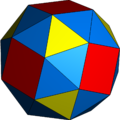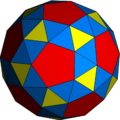 Snub cubeor Snub cuboctahedron |
 Snub dodecahedronor Snub icosidodecahedron |
Ingeometry, a snub is an operation applied to a polyhedron. The term originates from Kepler's names of two Archimedean solids, for the snub cube (cubus simus) and snub dodecahedron (dodecaedron simum).[1]


In general, snubs have chiral symmetry with two forms: with clockwise or counterclockwise orientation. By Kepler's names, a snub can be seen as an expansion of a regular polyhedron: moving the faces apart, twisting them about their centers, adding new polygons centered on the original vertices, and adding pairs of triangles fitting between the original edges.
The terminology was generalized by Coxeter, with a slightly different definition, for a wider set of uniform polytopes.
John Conway explored generalized polyhedron operators, defining what is now called Conway polyhedron notation, which can be applied to polyhedra and tilings. Conway calls Coxeter's operation a semi-snub.[2]
In this notation, snub is defined by the dual and gyro operators, as s = dg, and it is equivalent to an alternation of a truncation of an ambo operator. Conway's notation itself avoids Coxeter's alternation (half) operation since it only applies for polyhedra with only even-sided faces.
| Forms to snub | Polyhedra | Euclidean tilings | Hyperbolic tilings | |||
|---|---|---|---|---|---|---|
| Names | Tetrahedron | Cubeor octahedron |
Icosahedronor dodecahedron |
Square tiling | Hexagonal tilingor Triangular tiling |
Heptagonal tilingor Order-7 triangular tiling |
| Images | ||||||
| Snubbed form Conway notation |
sT | sC = sO | sI = sD | sQ | sH = sΔ | sΔ7 |
| Image | ||||||
In 4-dimensions, Conway suggests the snub 24-cell should be called a semi-snub 24-cell because, unlike 3-dimensional snub polyhedra are alternated omnitruncated forms, it is not an alternated omnitruncated 24-cell. It is instead actually an alternated truncated 24-cell.[3]
| Seed | Rectified r |
Truncated t |
Alternated h | |
|---|---|---|---|---|
| Name | Cube | Cuboctahedron Rectified cube |
Truncated cuboctahedron Cantitruncated cube |
Snub cuboctahedron Snub rectified cube |
| Conway notation | C | CO rC |
tCO trC or trO |
htCO = sCO htrC = srC |
| Schläfli symbol | {4,3} | or r{4,3} | or tr{4,3} | htr{4,3} = sr{4,3} |
| Coxeter diagram | or | or | or | |
| Image |
Coxeter's snub terminology is slightly different, meaning an alternated truncation, deriving the snub cube as a snub cuboctahedron, and the snub dodecahedron as a snub icosidodecahedron. This definition is used in the naming of two Johnson solids: the snub disphenoid and the snub square antiprism, and of higher dimensional polytopes, such as the 4-dimensional snub 24-cell, with extended Schläfli symbol s{3,4,3}, and Coxeter diagram .
Aregular polyhedron (or tiling), with Schläfli symbol , and Coxeter diagram , has truncation defined as , and , and has snub defined as an alternated truncation , and . This alternated construction requires q to be even.
Aquasiregular polyhedron, with Schläfli symbol orr{p,q}, and Coxeter diagram or , has quasiregular truncation defined as ortr{p,q}, and or , and has quasiregular snub defined as an alternated truncated rectification orhtr{p,q} = sr{p,q}, and or .
For example, Kepler's snub cube is derived from the quasiregular cuboctahedron, with a vertical Schläfli symbol , and Coxeter diagram , and so is more explicitly called a snub cuboctahedron, expressed by a vertical Schläfli symbol , and Coxeter diagram . The snub cuboctahedron is the alternation of the truncated cuboctahedron, , and .
Regular polyhedra with even-order vertices can also be snubbed as alternated truncations, like the snub octahedron, as , , is the alternation of the truncated octahedron, , and . The snub octahedron represents the pseudoicosahedron, a regular icosahedron with pyritohedral symmetry.
The snub tetratetrahedron, as , and , is the alternation of the truncated tetrahedral symmetry form, , and .
| Seed | Truncated t |
Alternated h | |
|---|---|---|---|
| Name | Octahedron | Truncated octahedron | Snub octahedron |
| Conway notation | O | tO | htO or sO |
| Schläfli symbol | {3,4} | t{3,4} | ht{3,4} = s{3,4} |
| Coxeter diagram | |||
| Image |
Coxeter's snub operation also allows n-antiprisms to be defined as or , based on n-prisms or , while is a regular n-hosohedron, a degenerate polyhedron, but a valid tiling on the sphere with digonorlune-shaped faces.
| Image | ||||||||
|---|---|---|---|---|---|---|---|---|
| Coxeter diagrams |
|
|
|
|
|
|
... ... |
|
| Schläfli symbols |
s{2,4} | s{2,6} | s{2,8} | s{2,10} | s{2,12} | s{2,14} | s{2,16}... | s{2,∞} |
| sr{2,2} |
sr{2,3} |
sr{2,4} |
sr{2,5} |
sr{2,6} |
sr{2,7} |
sr{2,8}... ... |
sr{2,∞} | |
| Conway notation |
A2 = T | A3 = O | A4 | A5 | A6 | A7 | A8... | A∞ |
The same process applies for snub tilings:
| Triangular tiling Δ |
Truncated triangular tiling tΔ |
Snub triangular tiling htΔ = sΔ |
|---|---|---|
| {3,6} | t{3,6} | ht{3,6} = s{3,6} |
| Space | Spherical | Euclidean | Hyperbolic | |||||
|---|---|---|---|---|---|---|---|---|
| Image | ||||||||
| Coxeter diagram |
... | |||||||
| Schläfli symbol |
s{2,4} | s{3,4} | s{4,4} | s{5,4} | s{6,4} | s{7,4} | s{8,4} | ...s{∞,4} |
| Conway notation |
Spherical | Euclidean | Hyperbolic | |||||
|---|---|---|---|---|---|---|---|---|
| Image | ||||||||
| Coxeter diagram |
... | |||||||
| Schläfli symbol |
sr{2,3} | sr{3,3} | sr{4,3} | sr{5,3} | sr{6,3} | sr{7,3} | sr{8,3} | ...sr{∞,3} |
| Conway notation |
A3 | sT | sC or sO | sD or sI | sΗ or sΔ | |||
| Space | Spherical | Euclidean | Hyperbolic | |||||
|---|---|---|---|---|---|---|---|---|
| Image | ||||||||
| Coxeter diagram |
... | |||||||
| Schläfli symbol |
sr{2,4} | sr{3,4} | sr{4,4} | sr{5,4} | sr{6,4} | sr{7,4} | sr{8,4} | ...sr{∞,4} |
| Conway notation |
A4 | sC or sO | sQ | |||||
Nonuniform polyhedra with all even-valance vertices can be snubbed, including some infinite sets; for example:
| Snub square bipyramid |
|---|
| Snub hexagonal bipyramid |
| Image | ... | |||
|---|---|---|---|---|
| Schläfli symbols |
ss{2,4} | ss{2,6} | ss{2,8} | ss{2,10}... |
| ssr{2,2} |
ssr{2,3} |
ssr{2,4} |
ssr{2,5}... |
Snub star-polyhedra are constructed by their Schwarz triangle (p q r), with rational ordered mirror-angles, and all mirrors active and alternated.
| s{3/2,3/2} |
s{(3,3,5/2)} |
sr{5,5/2} |
s{(3,5,5/3)} |
sr{5/2,3} |
| sr{5/3,5} |
s{(5/2,5/3,3)} |
sr{5/3,3} |
s{(3/2,3/2,5/2)} |
s{3/2,5/3} |
In general, a regular polychoron with Schläfli symbol , and Coxeter diagram , has a snub with extended Schläfli symbol , and .
A rectified polychoron = r{p,q,r}, and has snub symbol = sr{p,q,r}, and .
There is only one uniform convex snub in 4-dimensions, the snub 24-cell. The regular 24-cell has Schläfli symbol, , and Coxeter diagram , and the snub 24-cell is represented by , Coxeter diagram . It also has an index 6 lower symmetry constructions as or s{31,1,1} and , and an index 3 subsymmetry as or sr{3,3,4}, and or .
The related snub 24-cell honeycomb can be seen as a or s{3,4,3,3}, and , and lower symmetry or sr{3,3,4,3} and or , and lowest symmetry form as or s{31,1,1,1} and .
A Euclidean honeycomb is an alternated hexagonal slab honeycomb, s{2,6,3}, and or sr{2,3,6}, and or sr{2,3[3]}, and .
Another Euclidean (scaliform) honeycomb is an alternated square slab honeycomb, s{2,4,4}, and or sr{2,41,1} and :
The only uniform snub hyperbolic uniform honeycomb is the snub hexagonal tiling honeycomb, as s{3,6,3} and , which can also be constructed as an alternated hexagonal tiling honeycomb, h{6,3,3}, . It is also constructed as s{3[3,3]} and .
Another hyperbolic (scaliform) honeycomb is a snub order-4 octahedral honeycomb, s{3,4,4}, and .
| Seed | Truncation | Rectification | Bitruncation | Dual | Expansion | Omnitruncation | Alternations | ||
|---|---|---|---|---|---|---|---|---|---|
| t0{p,q} {p,q} |
t01{p,q} t{p,q} |
t1{p,q} r{p,q} |
t12{p,q} 2t{p,q} |
t2{p,q} 2r{p,q} |
t02{p,q} rr{p,q} |
t012{p,q} tr{p,q} |
ht0{p,q} h{q,p} |
ht12{p,q} s{q,p} |
ht012{p,q} sr{p,q} |